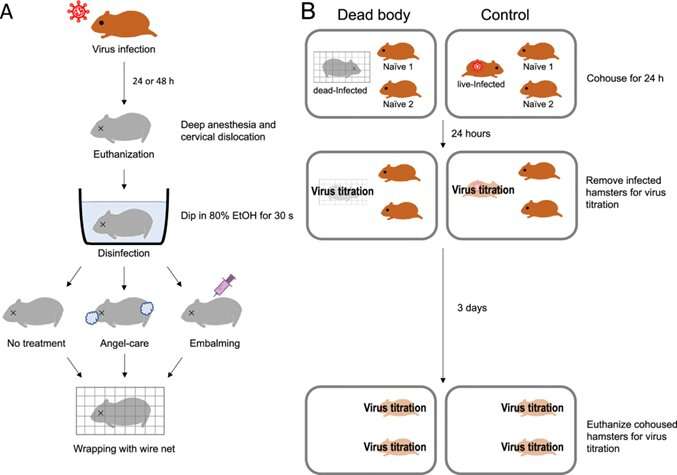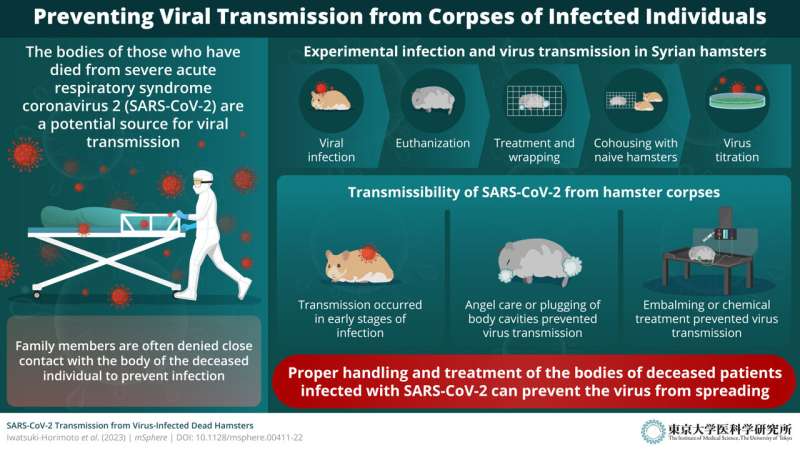This article has been reviewed according to Science X's editorial process and policies. Editors have highlighted the following attributes while ensuring the content's credibility:
fact-checked
trusted source
proofread
Scientists suggest guidelines to prevent SARS-CoV-2 transmission from deceased individuals

During the pandemic, COVID-19 control measures in several countries prevented family members from coming into contact with loved ones who died from the infection. This had an impact on cremation practices and caused emotional distress. Researchers from Japan have now shown that, while deceased SARS-CoV-2-infected individuals may be a potential source of the virus, transmission can be stopped by using appropriate procedures. Their research provides evidence for national guidelines.
The coronavirus disease 2019 (COVID-19) pandemic has presented unique challenges for clinicians, patients, and families. Of these, the death and loss of a loved one has been the one of the most painful and overwhelming. This psychological stress is compounded by the inability to see loved ones one last time and perform cremation rituals, due to the restrictions around exposure to the bodies of patients who died as a result of COVID-19.
Many medical facilities still refuse to allow bereaved family members to perform cremation for those who died from the infection. However, there is a lack of evidence to support these restrictions, and their acceptability varies between countries.
There have been reports of infectious severe acute respiratory syndrome coronavirus 2 (SARS-CoV-2) being found in individuals who died from the infection. However, it is unclear whether the virus can be transmitted from their bodies.
In Japan, nurses perform postmortem care or "angel care" for deceased persons by wiping their surfaces and shaving or applying chemicals. In addition, the body openings are plugged with cotton pads to prevent bodily fluid leakage.
In contrast, "embalming" or the treatment of a body to keep it from decaying, is common in the United States and Canada, and has recently become popular in Japan. How these practices impact the risk of infection from deceased persons, particularly for infection with SARS-CoV-2, is unknown.

To fill this knowledge gap, a research team from Japan has analyzed the possibility of SARS-CoV-2 transmission from a deceased individual's body by using a hamster model. They analyzed whether the virus can spread from COVID-19-infected dead hamsters, and whether this spread can be reduced by using angel care and embalming.
Their recent work was published in mSphere on January 10, 2023. Sharing the motivation behind their investigation, Prof. Kawaoka states, "It has been two and a half years since the COVID-19 pandemic began, and the transmissibility of SARS-CoV-2 from the body of a deceased, infected person still remains unclear."
The researchers infected Syrian hamsters with SARS-CoV-2/UT-NCGM02/human/2020 (the Wuhan strain of the virus) before euthanizing them and treating the bodies with either angel care or embalming (7% formaldehyde and 4% glutaraldehyde) treatment. As a control, one group of hamster bodies was treated with alcohol and wrapped in wire nets. Healthy hamsters were then co-housed with the bodies for 24 hours and their organs were collected to check for transmission of the virus.
High SARS-CoV-2 titers were found in the lungs and nasal turbinate of some hamsters who shared a house with a dead infected hamster, implying a risk of infection. In contrast, angel care was effective in preventing the leakage of gas and bodily fluid leakage from the bodies, effectively preventing infection of the co-housed hamsters. Embalming also prevented the transmission of virus to any of the live hamsters.
Prof. Kawaoka explains, "Infectious viruses may be transmitted via postmortem gases produced during the decomposition process or other postmortem changes in the dead body. Angel care or embalming could prevent this transmission."
In summary, these findings emphasize the importance of avoiding infection when handling the body of a deceased individual who had SARS-CoV-2 infection, and that sealing body cavities can control virus spread even if embalming is not performed. Prof. Kawaoka concludes by saying, "We do know that the virus remains in the bodies of deceased persons, but with appropriate precautions and guidelines, we can at least let the families see their loved ones once before they depart."
These findings could guide local and national guidelines on funerary rites and provide a modicum of solace to those who lose loved ones to COVID-19.
More information: Kiyoko Iwatsuki-Horimoto et al, SARS-CoV-2 Transmission from Virus-Infected Dead Hamsters, mSphere (2023). DOI: 10.1128/msphere.00411-22
















